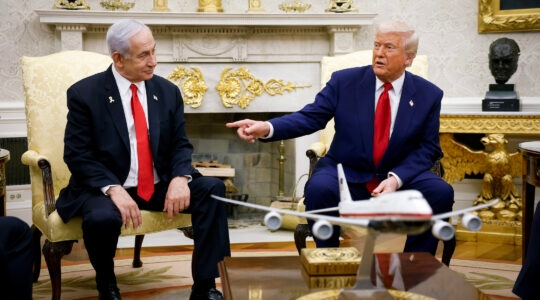JERUSALEM (JTA) – For Sindy Benavides, a Hispanic community organizer from Virginia who was visiting Israel last week, the Jewish community is a newfound friend.
Three years ago, Benavides said, she had the “frightening” experience of seeing the number of anti-immigration bills introduced in the Virginia House of Representatives triple to 148 — a reaction, she said, to the influx of Latino immigrants in the area.
With funding and training from the American Jewish Committee, Benavides and her fellow Latino community members mobilized to defeat about 100 of the bills in the 2006-07 legislative session – all those whose passage ran counter to the interests of their community.
Benavides, now 27, called the help she received from the organized Jewish world “invaluable.”
The collaboration is an example of the alliances Jewish groups are forming with the U.S. Hispanic community, now the largest minority community in the United States.
Last week, Benavides was one of about a dozen or so prominent Latina leaders who came to Israel under the auspices of Project Interchange, an educational institute of the AJC, in cooperation with the National Council of La Raza, the largest Hispanic advocacy organization in the United States.
“There is a great deal of commonality between the Hispanic and Jewish communities,” Latina political consultant Ana Navarro told JTA in Jerusalem. “It would do us all good to get to know each other better.”
For decades, the American Jewish and Hispanic communities have been indifferent to one another, says Dina Siegel Vann, director of AJC’s Latino and Latin American Institute. But the two communities share the common history of immigration, and their domestic interests often dovetail, particularly on civil rights issues. It behooves the Jewish community to seek a deeper relationship as the Latino community grows in numbers, she said.
The visit to Israel was a way to introduce Israel to several key Latina community leaders. The participants also met with women leaders in Israel, including Bank Hapoalim owner Shari Arison, and government leaders.
The Latina women traveled all around Israel, meeting Ethiopians in an absorption center in Safed, talking with Palestinians in Jerusalem, visiting religious sites in Jerusalem’s Old City, and taking in a tour highlighting the strategic value to Israel of the Golan Heights.
In a visit that had resonance for many of the Latinas, the group also visited Beit Hatfutsot, a Tel Aviv museum focusing on the Jewish Diaspora where they learned how Jews have kept their culture in exile while integrating into their host countries.
The Jewish state does not get a great deal of coverage in Hispanic media, Navarro said, and the trip enabled her to learn firsthand about Israel.
Navarro — who was born in Nicaragua and emigrated to the United States with her family during the Nicaraguan revolution in 1980 — said she was particularly interested in learning how Israel has assimilated Jewish refugees from so many countries around the world. She said she was struck by how Israelis are accustomed to living in “survival mode,” and that they are so dedicated to the defense of their homeland.
“Israelis are staunch, strong and educated,” Navarro, 38, said.
The trip underscored the need for Hispanic and Jewish communities in America “to foster further the understanding of each other’s experiences and challenges,” she said.
Benavides, who came to the United States from Honduras at the age of 1, echoed that sentiment. She said she was impressed at how Israel and the Jewish community found “a place at the table, a place in the world,” and believes the Jewish and Hispanic communities have a lot to learn from each other.
She said her visit to Israel was “only the beginning. I see myself looking more closely when I get home.”
“That is why it is so important to bring these women to Israel,” Vann said. It “makes the Israeli and Jewish experience relevant to the Latina experience.”
Vann is both Hispanic and Jewish. Born in Mexico, she came to the United States in 1996. As someone who speaks both the actual language and the cultural language of the two communities, Vann said she is trying to act as a bridge between Jews and Latinos.
Coalition-building has always been an important part of the Jewish community’s strategy in both advocacy and politics, Vann said, and having a close relationship with the largest minority group in the United States can be very beneficial to the Jewish community.
This was the AJC’s seventh mission to Israel involving Latin American or Hispanic groups. Other groups have included Latin American journalists, Latin American government officials and Hispanic businessmen.
JTA has documented Jewish history in real-time for over a century. Keep our journalism strong by joining us in supporting independent, award-winning reporting.





